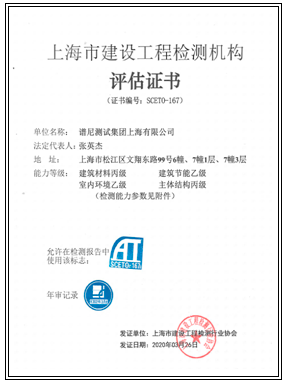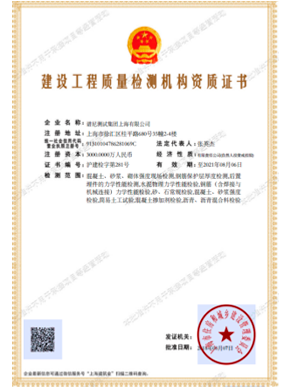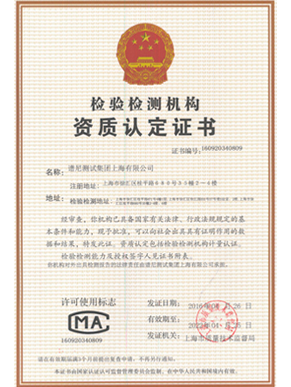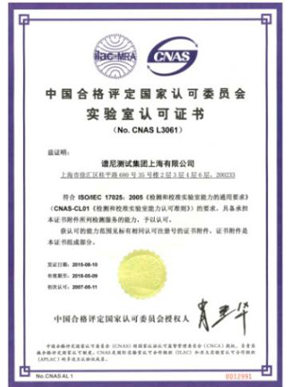
The building materials laboratory is equipped with sophisticated instruments and equipment, and experienced technical personnel. According to the standard method, it can provide technical services for construction engineering testing for customers. The laboratory area is 1500 square meters, and there are more than 400 sets of equipment. According to the relevant national laws, regulations and mandatory standards for engineering construction, the sampling inspection of the items involving structural safety and the witness sampling and testing of the building materials and components entering the construction site are carried out. In order to ensure the quality and safety of construction projects, the quality of building materials used shall comply with the relevant national construction quality acceptance standards / specifications.
Qualification certificate of Building Materials Laboratory:
1、The company has been issued by Shanghai market supervision bureau
2、Our company has been awarded (laboratory accreditation certificate) by China National Accreditation Commission for conformity assessment
3、The company has been approved by Shanghai housing and Urban Rural Construction Management Committee (qualification certificate of construction project quality inspection organization)
4、The company obtained the Shanghai Construction Engineering Inspection Industry Association (evaluation certificate)




Product name | Test standard | Test items |
Molded polystyrene foam | GB/T 10801.1-2002 | Dimension measurement |
appearance | ||
Apparent density | ||
compressive strength | ||
thermal conductivity | ||
Water vapor transmission coefficient | ||
Water absorption | ||
dimensional stability | ||
Fusibility | ||
Oxygen index | ||
Combustion classification | ||
Extruded polystyrene foam | GB/T 10801.2-2002 | Specification and size |
Allowable deviation | ||
Appearance quality | ||
compressive strength | ||
Water absorption | ||
Moisture permeability coefficient | ||
thermal resistance | ||
thermal conductivity | ||
dimensional stability | ||
combustion performance | ||
Foam glass insulation products | JC/T 647-2014 | Verticality deviation |
bend | ||
Appearance defect | ||
Dimension and its allowable deviation | ||
Allowable deviation of density | ||
thermal conductivity | ||
compressive strength | ||
Flexural strength | ||
Volumetric water absorption | ||
Moisture permeability coefficient | ||
Tensile strength perpendicular to plate surface | ||
dimensional stability | ||
Water absorption | ||
Alkali resistance | ||
Frost resistance | ||
Thermal shock resistance | ||
combustion performance | ||
Rock wool products for external thermal insulation of building exterior wall | GB/T 25975-2010 | Appearance quality |
Dimension and allowable deviation | ||
Right angle deviation | ||
Flatness deviation | ||
dimensional stability | ||
Mass moisture absorption rate | ||
Acidity coefficient | ||
Slag ball content | ||
Hydrophobicity rate | ||
Short term water absorption | ||
thermal conductivity | ||
Tensile strength perpendicular to the surface | ||
compressive strength | ||
combustion performance | ||
Long term water absorption | ||
Water vapor permeability |
Preformed flexible elastomeric cellular thermal insulation | GB/T 17794-2008 | Allowable dimension deviation |
Appearance quality | ||
Apparent density | ||
thermal conductivity-20℃ | ||
Thermal conductivity 0 ℃ | ||
Thermal conductivity 40 ℃ | ||
Moisture permeability coefficient and moisture rent factor | ||
combustion performance | ||
dimensional stability | ||
Compression rebound rate | ||
Vacuum water absorption | ||
Smoke density | ||
Oxygen index | ||
Rigid phenolic foam products for insulation (PF) | GB/T 20974-2014 | appearance |
Apparent density and its allowable deviation | ||
Size and allowable deviation | ||
Allowable value of diagonal difference | ||
Flatness | ||
Straightness | ||
combustion performance | ||
verticality | ||
thermal conductivity | ||
compressive strength | ||
Bending fracture force | ||
dimensional stability | ||
Moisture permeability coefficient | ||
Volumetric water absorption | ||
Rock wool thermal insulation products for construction | GB/T19686-2015 | appearance |
Size and density | ||
Average fiber diameter | ||
Slag ball content | ||
thermal conductivity | ||
combustion performance | ||
Radionuclide | ||
Mass moisture absorption rate | ||
Acidity coefficient | ||
Humidity resistance factor | ||
Hydrophobicity rate | ||
Tensile strength perpendicular to the surface | ||
compressive strength | ||
Point load | ||
shear strength | ||
Water absorption of full immersion volume | ||
Short term water absorption | ||
Long term water absorption | ||
Glass wool and its products for thermal insulation | GB/T13350-2008 | Appearance, shell eccentricity |
Size, density | ||
Thermal conductivity, thermal resistance (average temperature 25 ℃) | ||
Hot load shrinkage temperature | ||
combustion performance | ||
Moisture absorption rate | ||
Average fiber diameter | ||
Moisture content | ||
Hydrophobicity rate | ||
Slag ball content | ||
Water absorption | ||
Organic matter content |
Paper faced gypsum board | GB/T9775-2008 | Appearance quality |
Dimensional deviation | ||
Adhesion between face paper and core material | ||
Section size of wedge edge | ||
Stability in case of fire | ||
hardness | ||
Fracture load | ||
Diagonal length difference | ||
Area density | ||
Impact resistance | ||
Water absorption | ||
Surface water absorption | ||
Rigid polyurethane foam for building insulation | GB/T 21558-2008 | Dimensional deviation |
appearance | ||
Core density | ||
Compressive strength or compressive stress at 10% deformation | ||
thermal conductivity | ||
dimensional stability | ||
Water vapor transmission coefficient | ||
Water absorption | ||
combustion performance | ||
Heat insulation sandwich panel for combined cold storage | JB/T 6527-2006 | Appearance quality |
Dimensional deviation | ||
Peeling performance | ||
Bending capacity | ||
Diagonal difference | ||
Bending strength | ||
density | ||
thermal conductivity | ||
dimensional stability | ||
compressive strength | ||
Water absorption | ||
Oxygen index | ||
Bond strength | ||
Mineral wool spray insulation | GB/T26746-2011 | appearance |
Average fiber diameter | ||
Slag ball content | ||
Thickness tolerance | ||
Allowable deviation of bulk density | ||
thermal conductivity | ||
Mass moisture absorption rate | ||
Bond strength | ||
combustion performance | ||
Hydrophobicity rate | ||
Water absorption | ||
Concrete interface treatment agent | JC/T 907-2018 | Tensile bond strength / untreated |
Tensile bond strength / after treatment (immersion) | ||
Tensile bond strength / after treatment (heat resistant) | ||
Tensile bond strength / after treatment (freeze-thaw resistance) | ||
Tensile bond strength / after treatment (reduction resistance) | ||
Tensile bond strength / cooling time | ||
Lateral deformation |
Anchor bolt | JG/T 366-2012 | Dimensions and tolerances |
Standard value of tensile bearing capacity of anchor bolt | ||
Standard value of uplift force of anchor bolt disc | ||
Influence of bit wear on standard value of tensile bearing capacity of anchor bolt | ||
Tensile bond strength / after treatment (reduction resistance) | ||
Influence of ambient temperature on standard value of anchor bolt bearing capacity | ||
Failure torque of screw in anchor bolt | ||
Glass fiber mesh for reinforcement | JC/T 561.2-2006 | Mass per unit area |
Tensile Strength | ||
Reduced breaking strength | ||
Retention rate of reduced breaking strength | ||
Elongation at break (warp and weft) | ||
Alkali resistant glass fiber mesh | JC/T 841-2007 | Mass per unit area |
Tensile Strength | ||
Alkali resistance | ||
elongation at break | ||
Longitude and latitude density | ||
combustible matter content | ||
an adhesive | JC/T 992-2006(2017) | Tensile bond strength (with cement mortar) / original strength |
Tensile bond strength (with cement mortar) / water resistance | ||
Tensile bond strength (with cement mortar) / freeze thaw resistance | ||
Tensile bond strength (with polystyrene board) / original strength | ||
Tensile bond strength (with polystyrene board) / water resistance | ||
Tensile bond strength (with polystyrene board) / freeze-thaw resistance | ||
Operational time | ||
Ceramic tile adhesive | JC/T 547-2017 | 6h tensile bond strength |
Bond tensile strength | ||
Tensile bond strength after immersion | ||
Tensile bond strength after thermal aging | ||
Tensile bond strength after freeze-thaw cycles | ||
Cooling time ≥ 10min, tensile bond strength | ||
Cooling time ≥ 20min, tensile bond strength | ||
When the cooling time is longer than 30min, the tensile bond strength is increased | ||
Shear bond strength | ||
Shear bond strength of 7D in air and 7d in water | ||
Shear bond strength after immersion in air for 21 days and immersion for 7 days | ||
Shear bond strength after thermal aging | ||
slippage | ||
Lateral deformation | ||
Facing mortar | JC/T 1024-2017 | Bond tensile strength |
Aging cycle tensile bond strength | ||
Operational time | ||
appearance | ||
Flexural strength | ||
compressive strength | ||
Water absorption | ||
Anti pan alkaline | ||
Initial drying crack resistance | ||
Lateral deformation | ||
Plastering mortar | GB/T 29906-2013 | Tensile bond strength (with moulded board) / original strength |
Tensile bond strength (with moulded board) / water resistance (soaking for 48h, drying for 2h) | ||
Tensile bond strength (with moulded board) / water resistance (soaking for 48h, drying for 7D) | ||
Operational time (cement based) | ||
Impact resistance | ||
Water absorption | ||
Impermeability | ||
Flexibility / compression ratio (cement based) | ||
Flexibility / cracking strain |
adhesive | GB/T 29906-2013 | Tensile bond strength (with cement mortar) / original strength |
Tensile bond strength (with cement mortar) / water resistance (soaking for 48h, drying for 2h) | ||
Tensile bond strength (with cement mortar) / water resistance (soaking for 48h, drying for 7D) | ||
Tensile bond strength (with moulded board) / original strength | ||
Tensile bond strength (with moulded board) / water resistance (soaking for 48h, drying for 2h) | ||
Tensile bond strength (with moulded board) / water resistance (soaking for 48h, drying for 7D) | ||
Operational time (cement based) | ||
Mesh fabric | GB/T 29906-2013 | Mass per unit area |
Reducing breaking strength (warp and weft) | ||
Retention rate of reducing breaking strength (warp and weft) | ||
Elongation at break (warp and weft) | ||
Plastering mortar | GB/T 30595-2014 | Tensile bond strength (with extruded panel) / original strength |
Tensile bond strength (with extruded panel) / water resistance (soaking for 48h, drying for 2h) | ||
Tensile bond strength (with extruded panel) / water resistance (soaking for 48h, drying for 7D) | ||
Operational time | ||
Impact resistance | ||
Water absorption | ||
Compression ratio | ||
an adhesive | GB/T 30595-2014 | Tensile bond strength (with cement mortar) / original strength |
Tensile bond strength (with cement mortar) / water resistance (soaking for 48h, drying for 2h) | ||
Tensile bond strength (with cement mortar) / water resistance (soaking for 48h, drying for 7D) | ||
Tensile bond strength (with extruded panel) / original strength | ||
Tensile bond strength (with extruded panel) / water resistance (soaking for 48h, drying for 2h) | ||
Tensile bond strength (with extruded panel) / water resistance (soaking for 48h, drying for 7D) | ||
Operational time (cement based) | ||
Mesh fabric | GB/T 30595-2014 | Mass per unit area |
Reducing breaking strength (warp and weft) | ||
Retention rate of reducing breaking strength (warp and weft) | ||
Elongation at break (warp and weft) | ||
Interface treatment agent | GB/T 30595-2014 | State in container |
Freeze thaw stability (3 times) | ||
storage stability | ||
nonvolatile content | ||
Plastering mortar | DG/TJ 08-2126-2013 | Tensile bond strength (with cement mortar) / standard state |
Tensile bond strength (with cement mortar) / soaking for 48h and drying for 2h | ||
Tensile bond strength (with rock wool board) / standard state | ||
Tensile bond strength (with rock wool board) / soaking for 48h and drying for 2h | ||
Tensile bond strength (combined with rock wool tape / rock wool board / strip) / standard state | ||
Tensile bond strength (with rock wool belt / combined board with rock wool board) / soaking for 48 h and drying for 2 h | ||
Operational time | ||
Flexibility / compression ratio | ||
an adhesive | DG/TJ 08-2126-2013 | Tensile bond strength (with cement mortar) / standard state |
Tensile bond strength (with cement mortar) / soaking for 48h and drying for 2h | ||
Tensile bond strength (with rock wool board) / standard state | ||
Tensile bond strength (with rock wool board) / soaking for 48h and drying for 2h | ||
Tensile bond strength (combined with rock wool tape / rock wool board / strip) / standard state | ||
Tensile bond strength (with rock wool belt / combined board with rock wool board) / soaking for 48 h and drying for 2 h | ||
Operational time | ||
Wire and cable | GB/T 5013.3-2008 | Conductor resistance |
Cross sectional area | ||
GB/T 5023.3-2008 | Conductor resistance | |
Cross sectional area | ||
GB/T 3956-2008 | Conductor resistance | |
Cross sectional area |